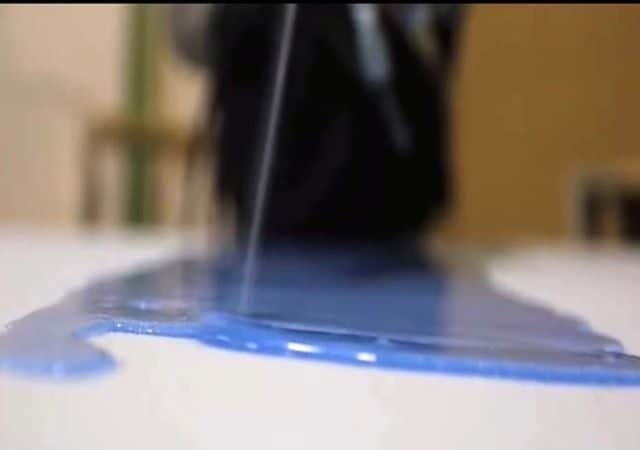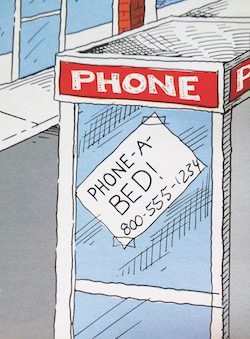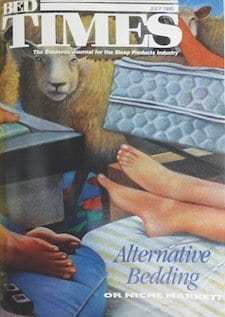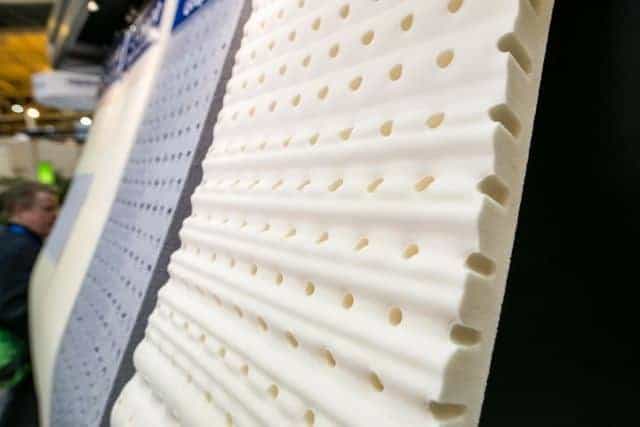The International Sleep Products Association’s first 100 years—Part II of the fourth and final installment
Construction junction: Specialty sleep leads mattress trends
When it came to bedding constructions, 1991-2015 was an era when memory and other foams became unforgettable components in mattresses and airbeds took off in popularity.
Mattresses like these were classified as “alternative” or “niche” sleep in the 1990s and were sometimes shown in separate bedding markets. But, by 2015, the line between “traditional” bedding and “specialty” had blurred so much as to nearly disappear.
A number of factors helped propel the success of foam bedding
- It started when bedding producers learned that a barrier layer of foam could help mattresses pass the cigarette-ignition test required by federal flammability standards since 1973.
Then, manufacturers of innerspring mattresses began to incorporate foam layers to create the plush, softer bedding surfaces that consumers sought after decades of wanting extra-extra-extra firm mattresses, according to an article in the April 1990 issue of BedTimes magazine.
In the early 1990s, consumers weren’t quite ready to embrace foam-core mattresses, believing them to be “low quality, too hot and sweaty” options that would “dry up and crumble over time,” according to a BedTimes article in April 1991.
The biggest thing to propel foam-core bedding forward arguably was the founding of the Tempur-Pedic brand in 1992.
The company, which manufactures beds using its proprietary visco-elastic Tempur foam, advertised heavily, going directly to consumers with its message that its foam would relieve pressure points and eliminate motion transfer.
- Later, the growing popularity of adjustable bases would give another sales boost to foam mattresses, which articulated easily on the moveable platforms.
- Over the course of the era, dozens of startup companies introduced their own versions of visco-elastic bedding and major producers that were previously committed to innerspring mattresses unveiled foam-core lines.
With consumers increasingly open to foam constructions, in the 2000s, mattress makers began to revisit latex, a component that had seemed poised to catch on before but, for various reasons, never quite did. Generally pricier than polyurethane and visco-elastic foams, manufacturers added latex-core models to the high end of their collections and incorporated thinner sheets of latex into the comfort layers of mattresses in more middling price points.
- Airbed popularity also soared during this time.
Mattress makers had toyed with airbeds since the 1950s, but it wasn’t until the late 1970s that the technology began to evolve enough to be a reliable bedding construction.
Comfortaire, established in 1981, was the earliest company to specialize in air.
Select Comfort was founded in 1987 and launched extensive direct-to-consumer ad campaigns highlighting that its Sleep Number airbeds allowed each sleeping partner to adjust the mattress’ comfort level individually. Unlike with foam, fewer companies jumped into producing their own airbeds, but consumers took to the category.
- In 2015, Select Comfort, which bought Comfortaire in 2013, was No. 5 on the list of Top 15 Bedding Producers compiled annually by the trade publication Furniture Today.
Other notable bedding trends in both product development and marketing during the period:
✦ Consumers fall in love with luxury. This era ushered in sumptuous bedding that pushed price points higher and higher. Luxe mattresses featured upscale fabrics and components in towering profiles, often finished with a plush pillow-top. Not uncommon were bed sets so thick they could have fooled the princess had the pea been hidden underneath.
Some major players entered the luxury market with their own brands. For instance, Sealy put energy and resources into its Stearns & Foster acquisition, while Spring Air launched Chatham & Wells. But virtually every mattress maker made a foray into high-end bedding with at least a collection or two.
“Initially, these price points were seen as ancillary items in the showroom, designed to offer the discerning customer the ‘very best’ and give the manufacturers an umbrella for premium products,” said James Siraguse, then national sales manager of Bassett Mattress, in an article in BedTimes in February 1999.
“The success of a few programs has encouraged more vendors to launch programs of their own that will offer high margins for the retailer. … The recent success stories of these programs have proven that they will be a viable part of the future of bedding.”
By the 2000s, price points between $5,000 and $8,000 were not uncommon in the super-premium category, with some bed sets carrying staggering price tags of $25,000, $30,000, even $50,000.
Still, super-luxe mattress sets—and their slightly lower-priced premium counterparts—were not without their drawbacks, especially when they first hit the marketplace. Older frames and sheet sets didn’t always accommodate the high-profile beds, which also tended to cover up existing headboards.
But every problem has a solution, and manufacturers began offering lower-profile foundations to reduce the overall height of beds, while linen suppliers introduced fitted sheets that easily slipped over deep mattresses, BedTimes reported in a March 1999 article.
✦ 
Foamers began adding gel—
either tiny beads or “swirls”—to create a cooling effect. Cutting, perforating and contouring foams and latex also helped propel air in and out of mattresses.
✦ Futon fever. Futons enjoyed a surge in popularity in the 1990s. “It’s a product that sleeps better than a sleeper sofa and that sits better than a daybed,” said Gary Witherbee of Wolf Corp., in an article in the July 1996 issue of BedTimes.
Futons were simpler for people to maneuver than sofa sleepers, were easier to move (whether from house to house or room to room) and had changeable covers to match any décor, proponents said.
At the same time, new components and construction methods made futon mattresses more comfortable. Prices in the mid-1990s averaged between $349 and $449 for frame, futon mattress and mattress cover.
✦ Single-sided beds put a stop to the “flip.”
When mattresses were stuffed with cotton, kapok and other early fillings, consumers needed to turn and rotate their mattresses regularly to keep them comfortable and extend their lives.
As their components evolved, mattresses needed less frequent maintenance, but manufacturers continued to recommend a regular schedule of turning and rotating, though they knew that fewer and fewer people—particularly those buying bulky queen- and king-size bedding-—were likely to follow their recommendations.
The industry rapidly abandoned two-sided mattresses after Simmons introduced its first single-sided (or “no-flip”) bed in 2000.
The mattresses made bedding maintenance easier for consumers and, for manufacturers, had an equally obvious benefit: They reduced the cost of ticking and comfort-layer components.
By 2015, a few manufacturers remained committed to producing two-sided products, but the vast majority of mattresses sold were single-sided.
✦ White rectangles go “green.”

The mattress industry responded with natural and organic latex, fabrics made from organic and renewable fibers, foams made without harmful chemicals, and foundations built using wood harvested from sustainable forests.
✦ “Hotel, motel, Holiday Inn.”
That’s a catchy lyric from the Sugarhill Gang’s 1979 hip-hop hit “Rapper’s Delight”—and also a key mattress trend. Manufacturers had been selling through hospitality channels since motels began to proliferate in the 1940s, but it wasn’t until the 1990s that hotels and mattress makers regularly teamed up to promote—and sell to consumers—mattresses made specifically for hoteliers.
Hotels upgrading their mattresses gained a competitive advantage and manufacturers added a new way to market their beds. The Westin’s Heavenly Bed, which debuted in 1999, was among the first and best known.
✦ Going directly to the consumer.

Napoleon Barragan launched Dial-A-Mattress, which sold mattresses by phone, 24 hours a day, 365 days a year.
When Internet sales became feasible, the company morphed into an online seller. Other companies, such as Tempur-Pedic, continued to sell through brick-and-mortar stores but shunned the industry’s tradition of co-op advertising with retailers and instead amped up their own marketing budgets to blanket consumer magazines with ads and TV stations with infomercials.
Select Comfort earned the Home Innovation Product Concept of the Year award for 2001 from the home-shopping channel QVC Inc.
“Some products—such as mattresses—have been thought ‘impossible’ to sell through QVC because they were either too bulky or just not something people buy without experiencing firsthand,” said Rod Ghormley, then QVC director of domestics and home furnishings, in an article in the March 2002 issue of BedTimes.
It wasn’t long before other manufacturers appeared on the proliferating home shopping channels.
View this entire special section as it appears in the print magazine: BedTimes November digital edition.
Read previous chapters in the 100-year history of ISPA:
1915-1940: An industry comes together
1941-1965: A time of war, a time for peace
1966-1990: The challenge of change








